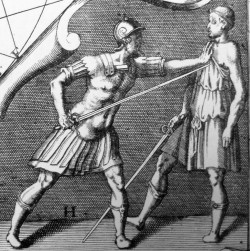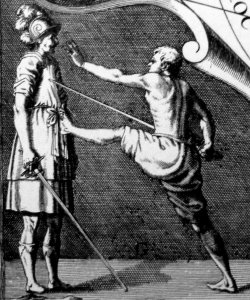George silver writes that a short man should use a sword of a yard and an inch while a larger man should use a sword of a yard plus three or four inches. He was talking about using a basket hilted backsword. I have been looking at historical sword lengths (of this period) and cannot find any that come close to his upper measurement (39-40 inches) most coming in at about 32 inches. Looking at the spotlight series in the features section it looks like most of the single handed swords across history come in on average at about 31-33 inches.
There is a nice chart on sword weights on this thread
http://www.myArmoury.com/talk/viewtopic.php?t...mp;start=0
Maybe we should not be suprised but could there be a median sword length and weight that holds true throughout culture and time for single handed swords?
I think Silver talking about overall length not blade length when he mentions a yard and an inch or yard and four inches. My Albion Crecy has a 35 5/8-inch blade but is 44 3/4-inch total. Considering that it is a war sword, and is too long to be the shorte sword of Silver's mention, this leads me to think he meant overall blade length. On a single handed sword, the blade lengths were typically between 28 - 34 inches, but with the overall lengths between 35 - 40 inches. If you look at the overall lengths, it is much more in line with Silver's recommendations.
Swords seem to meet a length in keeping with the technology of the time, the use it was put to use for (infantry use versus cavalry use), the owner's station, and the current fashion.
Swords seem to meet a length in keeping with the technology of the time, the use it was put to use for (infantry use versus cavalry use), the owner's station, and the current fashion.
| Neal Matheson wrote: |
| There is a nice chart on sword weights on this thread
http://www.myArmoury.com/talk/viewtopic.php?t...mp;start=0 Maybe we should not be suprised but could there be a median sword length and weight that holds true throughout culture and time for single handed swords? |
Well don't go telling Silverites that rapiers and basket-hilts have the same average length :)
Length seems clearly variable among sword types. Furthermore you'd have to ask yourself ig the averages you can find are truly significant. Even weights are clearly different on the chart you linked to, for exemple between complex hilts and hangers.
As for Silver sword length, I think it boils down to interpretation of text and picture. If I just read the text:
| Quote: |
| To know the perfect length of your sword, you shall stand with your sword and dagger drawn, as you see this picture, keeping out straight your dagger arm, drawing back your sword as far as conveniently you can, not opening the elbow joint of your sword arm, and look what you can draw within your dagger, that is the just length of your sword, to be made according to your own stature. |
When I do exactly that, specifically not opening the elbow joint, I land at a blade length of roughly 30in (I'm 6 feet tall). Of course it depends on what meaning you assign to convinently ;) I can draw a longer blade if I stretch the shoulders back a bit... This seems to match the surviving specimens.
If you look at the picture, he has the hilt almost at the hip, with the elbow opened a bit. In that position I can draw 40in of blade... Almost a short rapier blade. In fact if I pull the thing a bit more I can draw the length that Thibault (a rapier master) advocates, and this is a blade from ground to navel. I don't think Silver would advocate a blade like this, even though it's on the short side for a rapier.
Overall I trust the text more than the picture here. The proportions are off. The position might be incorrectly depicted as well...
Regards,

Thibault illustrates how you should be able to push on the opponent's chest with the hand, keeping your hilt on your hip, and still use the point to wound. EDIT: updated for a clearer picture.
Last edited by Vincent Le Chevalier on Mon 15 Jun, 2009 2:45 pm; edited 1 time in total
Great replies, thanks chaps.
I suppose I should have said single handed cutting/thrusting weapons. I love the thibault pic thanks alot!
I suppose I should have said single handed cutting/thrusting weapons. I love the thibault pic thanks alot!
| Neal Matheson wrote: |
| I love the thibault pic thanks alot! |
You're welcome :)
Even better, he does it with the foot as well... I uploaded a new picture in my first post that has a much better quality. Does more justice to the detail of the original :cool:

Putting the point to the chest while pushing with the foot.
| Vincent Le Chevalier wrote: |
| Furthermore you'd have to ask yourself ig the averages you can find are truly significant. |
I remember years ago in a statistics class hearing that "the average person has one ovary and one testical." :eek: I guess we have to take averages with a grain of salt...
I think Silver meant what he wrote. I'm a man of meane stature (five foot ten) and I can easily draw a thirty-seven-inch blade within my dagger. Maybe I'm doing it wrong, but I've got thirty-seven inches between my right armpit and left hand. I don't know how I could get a lower measurement. Rapiers of his era could be enormous, so this would still be a short sword by comparison.
If surviving basket-hilt swords don't match his ideal length, that's likely because other folks had different ideas. John Smythe, for example, wanted blades between three-quarters of a yard and a full yard. Tons of historical weapons fall into that range.
If surviving basket-hilt swords don't match his ideal length, that's likely because other folks had different ideas. John Smythe, for example, wanted blades between three-quarters of a yard and a full yard. Tons of historical weapons fall into that range.
Silver is taken very seriously by WMA and I frequently see backsworders weilding very long swords and singlesticks according to his specifications. Silver complains about the length of other martial artists throughout his work claiming that they are too long (or of imperfect length if you like). He even says that some fencers use swords too log by up to a foot (49-52 inches by his reckoning). He does say that the blade of a longsword should be of the same length as a short sword so maybe his picture is right for him.
It's quite interesting trying to verify what a past master said through the record of historical arms
It's quite interesting trying to verify what a past master said through the record of historical arms
The average length of a one handed sword depends entirely on time and place.
A viking age sword has an average of ca 75cm blde length (29"), but with some examples longer than 90cm (3ft)
High medevial swords are longer, averaging ca 85 cm (33") with some types in the 95cm range, while late medevial swords are back to 75cm, before the long cut-and-thrust types of the early renesance.
Basically, this is a result of different defensive measures and the resulting fighting styles.
Viking age swords are made to manouver around large round shields to cut and slice largely unarmoured opponents. High medevial swords, on the other hand, are made to strike at the head and hands of an mail clad opponent over the edge of a kite or heater shield.
As better armour technolgy (helmets covering the side of the head, gauntlets and so on) made striking swords less efficient, one returns to shorter, manouverable stabbing blades.
The longer cut an thrust types of the renesance develop in a civilian setting, and are adopted for battlefield use as armour becomes less frequent.
For unarmoured duelling, range is a definite advantage, as rapid strikes can be effective from a relatively safe distance.
A sword that is to long, however, will be cumbersome in close combat, and move more slowly in feints and other manouveres.
Exactly where the perfect balance of range and speed lies would be a matter of personal taste. Silver has his view, but as he says himself, not everybody agreed with him.
If you look at the development after Silver's age, rapiers also grow shorter and more manouverable over time. (probably as a reaction to the specialication of the long rapiers, and the decline of the use of bucklers and off-hand daggers to improve the laters close defence) I'm not familiar with the lenghts of later broadswords, though.
A viking age sword has an average of ca 75cm blde length (29"), but with some examples longer than 90cm (3ft)
High medevial swords are longer, averaging ca 85 cm (33") with some types in the 95cm range, while late medevial swords are back to 75cm, before the long cut-and-thrust types of the early renesance.
Basically, this is a result of different defensive measures and the resulting fighting styles.
Viking age swords are made to manouver around large round shields to cut and slice largely unarmoured opponents. High medevial swords, on the other hand, are made to strike at the head and hands of an mail clad opponent over the edge of a kite or heater shield.
As better armour technolgy (helmets covering the side of the head, gauntlets and so on) made striking swords less efficient, one returns to shorter, manouverable stabbing blades.
The longer cut an thrust types of the renesance develop in a civilian setting, and are adopted for battlefield use as armour becomes less frequent.
For unarmoured duelling, range is a definite advantage, as rapid strikes can be effective from a relatively safe distance.
A sword that is to long, however, will be cumbersome in close combat, and move more slowly in feints and other manouveres.
Exactly where the perfect balance of range and speed lies would be a matter of personal taste. Silver has his view, but as he says himself, not everybody agreed with him.
If you look at the development after Silver's age, rapiers also grow shorter and more manouverable over time. (probably as a reaction to the specialication of the long rapiers, and the decline of the use of bucklers and off-hand daggers to improve the laters close defence) I'm not familiar with the lenghts of later broadswords, though.
Page 1 of 1
You cannot post new topics in this forumYou cannot reply to topics in this forum
You cannot edit your posts in this forum
You cannot delete your posts in this forum
You cannot vote in polls in this forum
You cannot attach files in this forum
You can download files in this forum
All contents © Copyright 2003-2006 myArmoury.com — All rights reserved
Discussion forums powered by phpBB © The phpBB Group
Switch to the Full-featured Version of the forum
Discussion forums powered by phpBB © The phpBB Group
Switch to the Full-featured Version of the forum